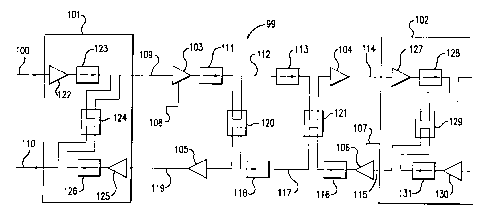Some of the information on this Web page has been provided by external sources. The Government of Canada is not responsible for the accuracy, reliability or currency of the information supplied by external sources. Users wishing to rely upon this information should consult directly with the source of the information. Content provided by external sources is not subject to official languages, privacy and accessibility requirements.
Any discrepancies in the text and image of the Claims and Abstract are due to differing posting times. Text of the Claims and Abstract are posted:
| (12) Patent: | (11) CA 2267781 |
|---|---|
| (54) English Title: | PATH TO PROVIDE OTDR MEASUREMENTS OF AN OPTICAL TRANSMISSION SYSTEM THAT INCLUDES OPTICAL ISOLATORS |
| (54) French Title: | CIRCUIT POUR MESURES PAR REFLECTOMETRIE OPTIQUE TEMPORELLE D'UN SYSTEME DE TRANSMISSION OPTIQUE COMPORTANT DES ISOLATEURS OPTIQUES |
| Status: | Expired and beyond the Period of Reversal |
| (51) International Patent Classification (IPC): |
|
|---|---|
| (72) Inventors : |
|
| (73) Owners : |
|
| (71) Applicants : |
|
| (74) Agent: | KIRBY EADES GALE BAKER |
| (74) Associate agent: | |
| (45) Issued: | 2007-07-10 |
| (86) PCT Filing Date: | 1997-10-15 |
| (87) Open to Public Inspection: | 1998-04-30 |
| Examination requested: | 2002-09-27 |
| Availability of licence: | N/A |
| Dedicated to the Public: | N/A |
| (25) Language of filing: | English |
| Patent Cooperation Treaty (PCT): | Yes |
|---|---|
| (86) PCT Filing Number: | PCT/US1997/018578 |
| (87) International Publication Number: | US1997018578 |
| (85) National Entry: | 1999-04-06 |
| (30) Application Priority Data: | ||||||
|---|---|---|---|---|---|---|
|
A path couples a pair of optical fibers in an optical transmission system. The
transmission system includes a plurality of optical
amplifiers (17, 18) placed along the transmission line (10, 12). Associated
with these optical amplifiers are optical isolators (21) that limit
the flow of optical energy to a single direction. The path allows reflected or
scattered light from one optical fiber after the optical isolator
to be returned via the other optical fiber. This enables an OTDR device to
obtain measurement information along the length of the fibers
between optical isolators (21).
Circuit reliant deux fibres optiques dans un système de transmission optique. Le système de transmission comporte une pluralité d'amplificateurs optiques (17, 18) placés le long de la ligne de transmission (10, 12). Des isolateurs optiques (21) associés à ces amplificateurs optiques limitent le flux d'énergie optique à une seule direction. Le circuit permet de renvoyer la lumière réfléchie ou dispersée provenant d'une fibre optique après un isolateur optique, via l'autre fibre optique. Ce procédé permet à un dispositif de réflectométrie optique temporelle d'obtenir des informations de mesure sur toute la longueur des fibres entre les isolateurs optiques (21).
Note: Claims are shown in the official language in which they were submitted.
Note: Descriptions are shown in the official language in which they were submitted.

2024-08-01:As part of the Next Generation Patents (NGP) transition, the Canadian Patents Database (CPD) now contains a more detailed Event History, which replicates the Event Log of our new back-office solution.
Please note that "Inactive:" events refers to events no longer in use in our new back-office solution.
For a clearer understanding of the status of the application/patent presented on this page, the site Disclaimer , as well as the definitions for Patent , Event History , Maintenance Fee and Payment History should be consulted.
| Description | Date |
|---|---|
| Time Limit for Reversal Expired | 2015-10-15 |
| Letter Sent | 2014-10-15 |
| Inactive: IPC expired | 2013-01-01 |
| Inactive: IPC expired | 2013-01-01 |
| Letter Sent | 2010-06-04 |
| Grant by Issuance | 2007-07-10 |
| Inactive: Cover page published | 2007-07-09 |
| Pre-grant | 2007-04-16 |
| Inactive: Final fee received | 2007-04-16 |
| Notice of Allowance is Issued | 2006-10-31 |
| Letter Sent | 2006-10-31 |
| Notice of Allowance is Issued | 2006-10-31 |
| Inactive: Approved for allowance (AFA) | 2006-10-23 |
| Amendment Received - Voluntary Amendment | 2006-08-21 |
| Inactive: S.30(2) Rules - Examiner requisition | 2006-02-20 |
| Letter Sent | 2004-02-04 |
| Letter Sent | 2002-10-31 |
| Request for Examination Received | 2002-09-27 |
| Request for Examination Requirements Determined Compliant | 2002-09-27 |
| All Requirements for Examination Determined Compliant | 2002-09-27 |
| Amendment Received - Voluntary Amendment | 2002-09-27 |
| Letter Sent | 2002-09-13 |
| Inactive: Cover page published | 1999-06-22 |
| Inactive: First IPC assigned | 1999-05-20 |
| Inactive: IPC assigned | 1999-05-20 |
| Inactive: IPC assigned | 1999-05-20 |
| Inactive: Notice - National entry - No RFE | 1999-05-06 |
| Application Received - PCT | 1999-05-05 |
| Application Published (Open to Public Inspection) | 1998-04-30 |
There is no abandonment history.
The last payment was received on 2006-09-25
Note : If the full payment has not been received on or before the date indicated, a further fee may be required which may be one of the following
Patent fees are adjusted on the 1st of January every year. The amounts above are the current amounts if received by December 31 of the current year.
Please refer to the CIPO
Patent Fees
web page to see all current fee amounts.
Note: Records showing the ownership history in alphabetical order.
| Current Owners on Record |
|---|
| TYCO ELECTRONICS SUBSEA COMMUNICATIONS LLC |
| Past Owners on Record |
|---|
| HOWARD D. KIDORF |